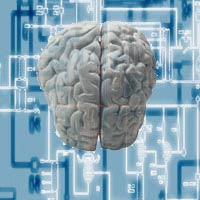[!] 'We must develop as quickly as possible technologies that make
possible a direct connection between brain and computer, so that artificial
brains contribute to human intelligence rather than opposing it.'
-- Stephen Hawking
This thread is a comprehensive set of resources for the emerging scientific field of silico-neural interfacing. This will be a closely moderated topic following the CIRA guidelines. Read here: http://www.imminst.org/cira Please feel free to add additional information after the chat on Sunday, Feb 16. but refrain from doing so until then.
Brief Background
Actually, the field has been around since the early 1900's when researchers began recording from neurons with single electrodes. This type of research comprises the sub-discipline of neuroscience known as electrophysiology. For the last century the state of the art was to insert one or more glass electrodes into a single neuron for recording or stimulation. Only in the last decade have scientists been able to record and stimulate large populations of neurons. The previous limitations of electrode technology and computational power have now been overcome.
The current state of the art in the field is a technology called multi-electrode array recording (and stimulation). There are two main branches for this kind of work: in vivo and in vitro experiments.
In vivo work consists of placing a number of electrodes directly into the brain of a live animal. Previously, this involved individually inserting microwires (extremely time consuming) Now, bundles of wires or a group of wires on small spikes are often used as an array. A more recent development is the use of printed circuit boards or semiconductor chips to create an array of electrodes on fine needles which can be inserted. Even further developments include the use of semiconductor arrays on flexible substrates that conform to the shape of the brain and the creation of arrays which use micromotors to reposition their electrodes so that a greater area can be sampled.
Working in vivo has the advantage of allowing you to look at what goes on in a live brain with all the complexity of the 'real' system (large scale questions about how the brain works). If instead you want more control of your system and you want to answer fundamental questions about how neural networks form and process information, you would use an in vitro system.
In vitro multi-electrode systems are typically glass dishes with an array of microelectrodes embedded in the bottom of the dish. On the dish a researcher will place a whole piece of nervous tissue, a slice, or a disassociated batch of embryonic neurons. In the case of the embryonic neurons you can observe all their network formation visually (through a microscope) in addition to recording their electrical activity.
Another in vitro option which has been tried, but has not been very successful, is growing neurons directly on the gates of silicon chips (i.e. the neurons become part of the circuitry) A neuron's tendency to crawl has made this approach difficult, because they won't stay put on the gates.
The technical challenges being attacked by researchers right now include:
[>] increasing signal to noise ratios of electrodes
[>] getting more electrodes in a smaller space (increased recording resolution)
[>] producing 3-D electrode arrays
[>] creating better signal processing software for separating individual neural signals
[>] creating better data interpretation software (A.l. pattern recognition) to deal with tremendous data flow coming out of these experiments.
[!] Following will be additional posts with resources for specific subject areas in the field
Best stuff,
Ocsrazor

















































